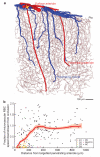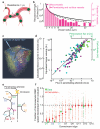Robust and fragile aspects of cortical blood flow in relation to the underlying angioarchitecture
- PMID: 25705966
- PMCID: PMC4393797
- DOI: 10.1111/micc.12195
Robust and fragile aspects of cortical blood flow in relation to the underlying angioarchitecture
Abstract
We review the organizational principles of the cortical vasculature and the underlying patterns of blood flow under normal conditions and in response to occlusion of single vessels. The cortex is sourced by a two-dimensional network of pial arterioles that feeds a three-dimensional network of subsurface microvessels in close proximity to neurons and glia. Blood flow within the surface and subsurface networks is largely insensitive to occlusion of a single vessel within either network. However, the penetrating arterioles that connect the pial network to the subsurface network are bottlenecks to flow; occlusion of even a single penetrating arteriole results in the death of a 500 μm diameter cylinder of cortical tissue despite the potential for collateral flow through microvessels. This pattern of flow is consistent with that calculated from a full reconstruction of the angioarchitecture. Conceptually, collateral flow is insufficient to compensate for the occlusion of a penetrating arteriole because penetrating venules act as shunts of blood that flows through collaterals. Future directions that stem from the analysis of the angioarchitecture concern cellular-level issues, in particular the regulation of blood flow within the subsurface microvascular network, and system-level issues, in particular the role of penetrating arteriole occlusions in human cognitive impairment.
Keywords: imaging; microvessels; penetrating vessels; pial vessels; rodent.
© 2015 John Wiley & Sons Ltd.
Figures










Similar articles
-
Collateral blood flow in different cerebrovascular hierarchy provides endogenous protection in cerebral ischemia.Brain Pathol. 2017 Nov;27(6):809-821. doi: 10.1111/bpa.12458. Epub 2017 Mar 27. Brain Pathol. 2017. PMID: 27859886 Free PMC article.
-
Microvascular basis for growth of small infarcts following occlusion of single penetrating arterioles in mouse cortex.J Cereb Blood Flow Metab. 2016 Aug;36(8):1357-73. doi: 10.1177/0271678X15608388. Epub 2015 Oct 13. J Cereb Blood Flow Metab. 2016. PMID: 26661182 Free PMC article.
-
Tortuosity and other vessel attributes for arterioles and venules of the human cerebral cortex.Microvasc Res. 2014 Jan;91:99-109. doi: 10.1016/j.mvr.2013.11.003. Epub 2013 Nov 27. Microvasc Res. 2014. PMID: 24291593
-
Neuronal units linked to microvascular modules in cerebral cortex: response elements for imaging the brain.Cereb Cortex. 1996 Sep-Oct;6(5):647-60. doi: 10.1093/cercor/6.5.647. Cereb Cortex. 1996. PMID: 8921201 Review.
-
Patterns of Cortical Visual Field Defects From Embolic Stroke Explained by the Anastomotic Organization of Vascular Microlobules.J Neuroophthalmol. 2018 Dec;38(4):538-550. doi: 10.1097/WNO.0000000000000733. J Neuroophthalmol. 2018. PMID: 30418333 Free PMC article. Review.
Cited by
-
Spatial and temporal patterns of nitric oxide diffusion and degradation drive emergent cerebrovascular dynamics.PLoS Comput Biol. 2020 Jul 27;16(7):e1008069. doi: 10.1371/journal.pcbi.1008069. eCollection 2020 Jul. PLoS Comput Biol. 2020. PMID: 32716940 Free PMC article.
-
The yin and yang of KV channels in cerebral small vessel pathologies.Microcirculation. 2018 Jan;25(1):10.1111/micc.12436. doi: 10.1111/micc.12436. Microcirculation. 2018. PMID: 29247493 Free PMC article. Review.
-
The Ion Channel and GPCR Toolkit of Brain Capillary Pericytes.Front Cell Neurosci. 2020 Dec 18;14:601324. doi: 10.3389/fncel.2020.601324. eCollection 2020. Front Cell Neurosci. 2020. PMID: 33390906 Free PMC article. Review.
-
The Role of Basement Membranes in Cerebral Amyloid Angiopathy.Front Physiol. 2020 Nov 25;11:601320. doi: 10.3389/fphys.2020.601320. eCollection 2020. Front Physiol. 2020. PMID: 33329053 Free PMC article. Review.
-
PIP2 as the "coin of the realm" for neurovascular coupling.Proc Natl Acad Sci U S A. 2021 May 25;118(21):e2106308118. doi: 10.1073/pnas.2106308118. Proc Natl Acad Sci U S A. 2021. PMID: 33952688 Free PMC article. No abstract available.
References
-
- Kleinfeld D, Denk W. Two-photon imaging of neocortical microcirculation. In: Yuste R, Lanni F, Konnerth A, editors. Imaging Neurons: A Laboratory Manual. Cold Spring Harbor Laboratory Press; Cold Spring Harbor: 1999. pp. 23.1–23.15.
-
- Tsai PS, Kleinfeld D. In vivo two-photon laser scanning microscopy with concurrent plasma-mediated ablation: Principles and hardware realization. In: Frostig RD, editor. Methods for In Vivo Optical Imaging. 2nd edition CRC Press; Boca Raton: 2009. pp. 59–115. - PubMed
-
- Kleinfeld D, Mitra PP. Applications of spectral methods in functional brain imaging. In: Yuste R, editor. Imaging: A Laboratory Manual. Cold Spring Harbor Laboratory Press; New York: 2011. pp. 12.1–12.7.
-
- Shih AY, Mateo C, Drew PJ, Tsai PS, Kleinfeld D. A polished and reinforced thinned skull window for long-term imaging and optical manipulation of the mouse cortex. Journal of Visualized Experiments. 2012 http://www.jove.com/video/3742 - PMC - PubMed
Publication types
MeSH terms
Grants and funding
- P20GM12345/GM/NIGMS NIH HHS/United States
- NS059832/NS/NINDS NIH HHS/United States
- DP1 OD006831/OD/NIH HHS/United States
- R21 MH072570/MH/NIMH NIH HHS/United States
- EB003832/EB/NIBIB NIH HHS/United States
- R21 NS059832/NS/NINDS NIH HHS/United States
- UL1TR000062/TR/NCATS NIH HHS/United States
- MH72570/MH/NIMH NIH HHS/United States
- RR021907/RR/NCRR NIH HHS/United States
- NS085402/NS/NINDS NIH HHS/United States
- R01 EB000790/EB/NIBIB NIH HHS/United States
- R01 NS057198/NS/NINDS NIH HHS/United States
- OD006831/OD/NIH HHS/United States
- R01 DA029706/DA/NIDA NIH HHS/United States
- UL1 TR000062/TR/NCATS NIH HHS/United States
- R01 EB003832/EB/NIBIB NIH HHS/United States
- NS082097/NS/NINDS NIH HHS/United States
- DP1 NS082097/NS/NINDS NIH HHS/United States
- R01 MH085499/MH/NIMH NIH HHS/United States
- R01 NS041096/NS/NINDS NIH HHS/United States
- R21 NS085402/NS/NINDS NIH HHS/United States
- R21 RR021907/RR/NCRR NIH HHS/United States
LinkOut - more resources
Full Text Sources
Other Literature Sources

